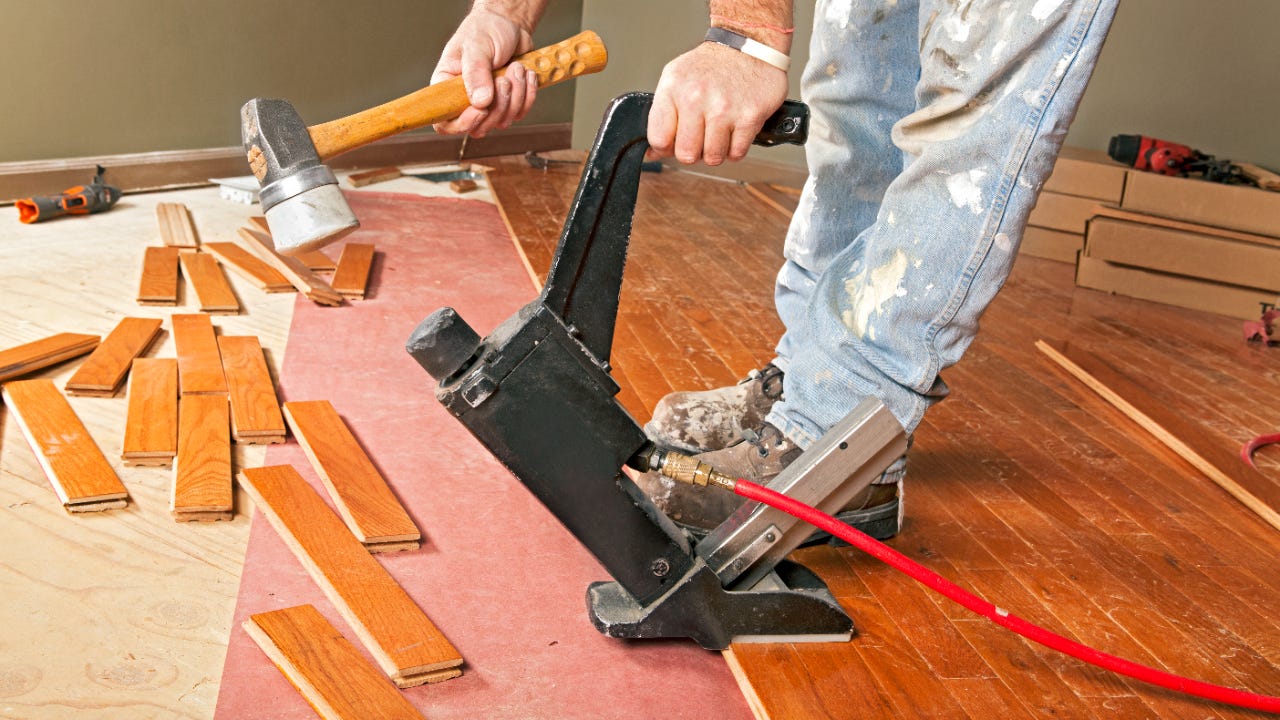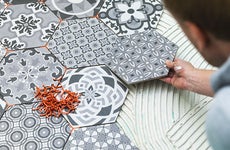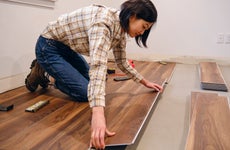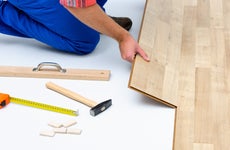How much hardwood flooring costs & how to save

The Bankrate promise
At Bankrate we strive to help you make smarter financial decisions. While we adhere to strict , this post may contain references to products from our partners. Here's an explanation for .
Key takeaways
- Hardwood floors can potentially have a positive ROI, unlike some other home improvement projects.
- Moving furniture, demolishing the current floor and preparing the subfloor will also need to be included in your budget.
- You can do some work yourself to save money, but working with a professional can prevent costly mistakes.
Hardwood flooring provides one of the best returns on investment. The National Realtor Association’s 2022 Remodeling Impact Report states that homeowners who install new wood flooring before selling their homes recoup 118 percent of the cost at resale — and refinishing old hardwood has a recovered cost of 147 percent. That means hardwood floors essentially pay for themselves if you plan on eventually selling your home.
But before deciding to take on this home improvement project, consider the cost of installation and materials. Hardwood is expensive, especially if you opt for a rarer wood. There are some steps you can take to save money along the way, but budgeting will be crucial if you want a good ROI.
The cost of hardwood flooring
The average cost to install hardwood flooring is between $6 to $25 per square foot, according to Angi. Where the cost goes up is when you include materials. And the cost may be higher — up to $45 per square foot — depending on the material, design and labor involved in installation.
Cost by material
Along with your preferences, your home plays a role in what types of wood can or can’t be used. For instance, thinner pieces of wood might warp in areas of your home that are prone to having more moisture. Type of wood, appearance and quality will all contribute to the cost of flooring.
- Type of wood. Stronger, more durable types of wood are more expensive. For instance, pine and acacia are less expensive, while walnut and teak are more expensive per square foot.
- Appearance.You’ll also need to look at the type of grain, texture and finish of the wood planks. The final appearance will depend on these factors and the length of the boards.
- Thickness of the planks. Certain wood can only be cut to certain thicknesses. The thicker the wood, the more expensive it will be.
- Quality of materials. Will Lau, a residential Realtor based in Southern California, suggests not to go cheap on flooring with the intention of renovating it again later. “Instead, see installing wood floors as an investment that can be enjoyed by you and your family.”
Wood prices vary, depending on the grade (quality) and thickness of the lot. Expect to pay anywhere from $4 to $20 on materials alone — not including labor.
| Wood type | Average price per square foot | Characteristics |
|---|---|---|
| Maple | $4-$15 | Highly durable and affordable; harder to install |
| Pine | $5-$10 | Warm tones and unique knotty look; affordable, but scratches and dents easily |
| Bamboo | $7-$19 | Light tones, contemporary look; eco friendly, but can be slippery |
| Hickory | $6-$14 | Dense grain patterns, durable |
| Red or white oak | $5-$12 | Natural color variations, long lasting, water resistant (white oak) |
| White ash | $6-$14 | Light color, hard to stain |
| Mahogany | $8-$14 | Rich color, harder to install, water resistant |
| Brazilian walnut | $9-$15 | Dark color; exotic and expensive, but long lasting |
Sources: Angi, Thumbtack
Cost by size
The size of the room — or rooms — you want to add hardwood to will also have a big impact on cost. A smaller room may cost as little as $600. A bigger project, like putting hardwood floors in a 4,000 square foot home, can quickly get to a six-figure price tag.
| Square Footage | Midrange Cost | High-End Cost |
|---|---|---|
| 100 | $600-$1,200 | $1,300-$2,500 |
| 250 | $1,500-$3,000 | $3,250-$6,250 |
| 500 | $3,000-$6,000 | $6,500-$12,500 |
| 1,000 | $6,000-$12,000 | $13,000-$25,000 |
| 1,500 | $9,000-$18,000 | $19,500-$37,500 |
| 2,000 | $12,000-$24,000 | $26,000-$50,000 |
| 2,500 | $15,000-$30,000 | $32,500-$62,500 |
| 3,000 | $18,000-$36,000 | $39,000-$75,000 |
| 4,000 | $24,000-$48,000 | $52,000-$100,000 |
Other cost factors
Labor is another big factor when it comes to putting down hardwood flooring, but it’s not the only one.
- Moving furniture out of the way. If you are only refinishing a single room, you may be able to move the furniture yourself. For a full remodel, you may need to hire professional movers and rent storage space for your furniture.
- Demolishing the existing floor. Labor costs typically include removing the old flooring, but you may be able to do this prep work yourself to save money.
- Preparing the subfloor. You won’t know this cost for sure until you pull out the original flooring, Lau says. The amount of work depends on the size of your home and the condition of your flooring. If your flooring is in less-than-stellar shape, it will cost more.
- Labor. Installation itself generally costs $3 to $6 a square foot, according to Angi — unless complications ensue. In general, expect labor costs to make up about 50 percent of your total floor installation budget, according to HomeGuide.
- Floor pattern. According to Rachel Zepernick, interior home expert at Angi, “The style you choose is another important factor in the cost of your hardwood flooring, with wide plank on one end, ranging from $2 to $12 per square foot, and genuine parquet on the other end, costing between $20 and $45 per square foot.”
- Trends and availability. Common flooring options will be the more affordable option, and much easier to source. On the other hand, a particularly trendy species or style — like wide planks, chevron patterns and hand-scraped engineered hardwoods currently — often has inflated prices, due to demand.
How to save on hardwood flooring costs
To save on costs, be prepared to do some thorough research — and at least some of the work yourself.
1. Refinish your existing wood floors
This is one of the most cost-effective options, Lau says. However, it’s only an option if you have solid wood floors or certain types of engineered wood. You can’t refinish laminate, which means you may be stuck ripping it out and replacing it with hardwood.
But refinishing does have the highest ROI, according to the Remodeling Impact Report. So if your house already has hardwood and you just want to change the stain, refinishing is the most cost-effective option.
2. Research materials
Since the type of wood you use plays a large role in the cost, research the typical prices for different species, grains, lengths and thicknesses of wood flooring. Tropical hardwoods will cost more on average, but each type of wood has a wide range of costs depending on quality.
In addition, you should be sure to buy in excess. The lot matters when you need to do touch-ups, so having extra will help avoid mismatched flooring in the future.
3. Decide on engineered versus solid wood
Wood for hardwood flooring comes in two main types: solid and engineered. While solid wood is a single layer of wood, engineered wood is made of several layers of plywood and hardwood.
Engineered wood is more durable and can be more expensive to buy, but it’s less expensive to install and less prone to warping. Solid wood can be less expensive to purchase, but it’s pricier to install.
4. Remove your furniture
Anything you can do to make it easy for workers will save on costs. Moving and covering your furniture means there’s less the installers need to handle.
You can also compare the cost of having your contractor’s team move your furniture to hiring movers. If you plan on redoing the flooring of your whole house and tackle other projects at the same time, it may be worth the price getting professional movers and a storage space until renovations are done.
5. Demo your old floor yourself
If you have the time and equipment to do it, demolish the existing flooring beforehand, Lau says. Removing the old flooring the tile and laminate yourself can help you save on labor costs. Be careful during the demo, though. You don’t want to mess up the subfloor and cause yourself an additional financial headache.
6. Do it yourself
You might want to do all or part of the job only if you have the experience to install hardwood floors. Otherwise, it might be more costly and time intensive to try to do it yourself only to have to hire someone to fix mistakes later.
How to finance the cost of hardwood flooring
To cover the costs of hardwood flooring, consider taking out a home improvement loan, a home equity loan or a home equity line of credit.
Home improvement loans
Home improvement loans are a type of personal loan meant specifically for projects like hardwood floor installation. They offer fixed rates and are good for covering set costs and are especially useful if you want to avoid using your home as collateral. If you have already gotten quotes from a contractor and know how much your project will cost, a home improvement loan may be the right option.
Keep in mind that lenders offering unsecured personal loans rely on your credit profile to determine both your eligibility and the rates and terms you’re offered. You’ll need to shop around to get the best personal loan rates. Comparing lenders is especially important when looking at bad credit loan rates, which tend to run much higher — sometimes up to 36 percent.
After prequalifying with at least three lenders use a personal loan calculator to find out how much your monthly payment will be.
Home equity loans
A home equity loan is similar to a home improvement loan. You receive a lump sum and pay back the loan over a set term, usually five to 20 years, although some loans may have terms up to 30 years.
However, your home is the collateral for the loan. This means you have access to more competitive rates, but if you are unable to repay, you risk losing your home.
Home equity lines of credit
A home equity line of credit (HELOC) also uses your home as collateral, but unlike a home equity loan, it functions similarly to a credit card.
Rather than receive a lump sum, you will have access to funds as you need them and can repay and reborrow as much as you need. The draw period is usually up to 10 years, and they are good for covering unexpected expenses that crop up during big projects like installing hardwood floors.
The bottom line
Doing your homework can give you a good idea of how much time and money it will take to purchase the materials and install hardwood flooring. Prepare for the project by having your plumbing inspected, hiring a consultant and creating a savings plan. If you need to spread out the cost of your new flooring, have your budget and financing figured out well in advance.
Related Articles



